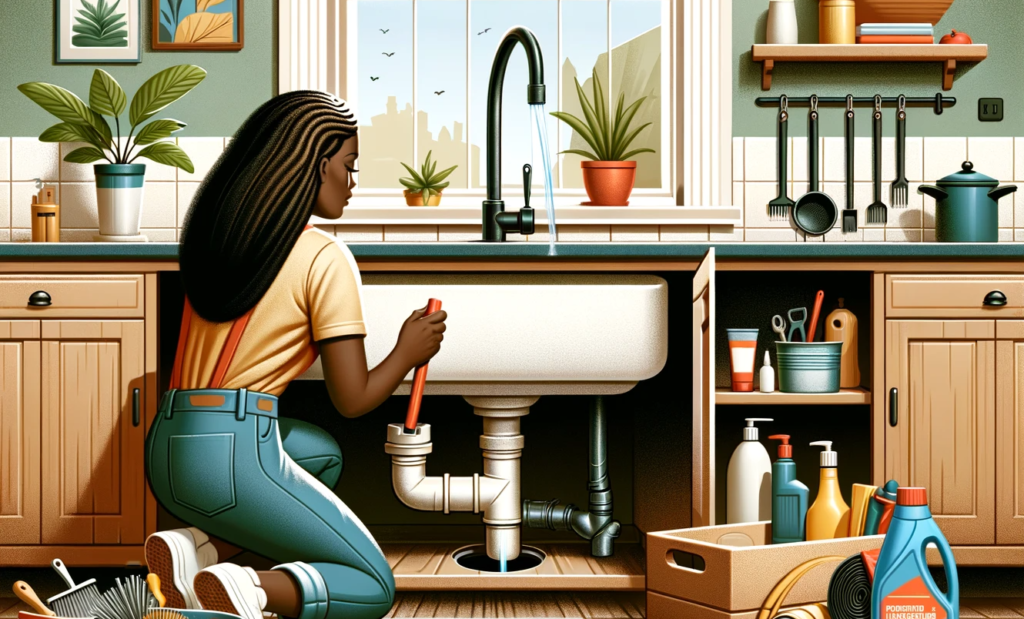Expert Drain Maintenance Tips for Homeowners

Drains are the unsung heroes of our homes, quietly whisking away wastewater and ensuring our domestic comfort. But when they start acting up, it can lead to all sorts of trouble, from unpleasant odors to severe water damage. As a homeowner who’s navigated the murky waters of drain maintenance, I’ve learned that a little knowledge and diligence can go a long way in preventing these issues.
Key Takeaways:
| Key Point | Explanation |
|---|---|
| Importance | Drains are crucial for home hygiene and comfort |
| Personal Experience | Sharing first-hand insights on maintaining drains |
| Prevention Focus | Highlighting the value of proactive maintenance |
Just last year, I faced a near-disaster when the kitchen sink backed up right before a big holiday gathering. The culprit? A buildup of grease and food particles that had been lurking beneath the surface. This experience taught me the stark reality that neglecting regular drain care can lead to emergencies at the worst possible times. Let’s delve into how you can avoid such a scenario.
Understanding Your Drain System
Before diving into maintenance, it’s essential to grasp the complexities of your home’s drainage system. Each fixture in your home, from your shower to your kitchen sink, connects to a labyrinth of pipes that ensure waste is transported away safely and efficiently.
How Residential Drains Work:
- The vertical pipes, known as stacks, carry waste downwards.
- The horizontal pipes, in contrast, evacuate waste out towards the sewer or septic system.
- Vent pipes are critical too, as they prevent vacuums and allow gases to escape.
Having a basic understanding can help you better maintain these systems and recognize when there’s a potential problem. For a deeper dive into the inner workings, check out Understanding Residential Drains on our website.
Drain System Components:
| Component | Function |
|---|---|
| Sink | Entry point for wastewater and solid waste |
| Toilet | Handles human waste and toilet paper |
| Bathtub | Drains water and soap residue |
| Pipes | Transport waste away from the home |
| Sewer Line | Connects home’s system to municipal treatment |
Recognizing what each part does within the system can save you headaches down the line. It’s all about appreciating the work these hidden heroes do and giving them the care they deserve.
Regular Drain Care and Cleaning
It’s no secret that the cornerstone of a well-functioning drain system lies in consistent maintenance and cleaning. Regularly attending to your drains can prevent buildup and keep everything running smoothly. Here are the steps I’ve woven into my weekly routine to keep my drains in top shape:
- Hot Water Flush: Once a week, I pour boiling water down the drain to melt away any grease or soap buildup.
- Baking Soda and Vinegar: A monthly ritual, I sprinkle half a cup of baking soda followed by a cup of vinegar. This natural duo fizzes away minor clogs and deodorizes the pipes.
- Strainers and Stopper Cleaning: After every use, I clean out strainers to prevent debris from going down the drain and give the stoppers a quick wash every month.
By incorporating these simple habits, I have significantly reduced the likelihood of clogs and bad odors. They require minimal effort but can profoundly impact the longevity of your plumbing system.
Recommended Products for Regular Maintenance:
- Baking Soda: Nature’s scrubber, it’s gentle yet effective.
- White Vinegar: For its disinfectant and reactive properties.
- Boiling Water: The easiest way to maintain flow.
- Strainers: Essential for catching hair and food particles before they cause trouble.
Remember, although using chemical drain cleaners might seem like a quick fix, they can actually harm your pipes over time. Stick to these natural solutions for a safer approach to drain care.
Preventing Clogs and Blockages
One of my biggest lessons in home maintenance is that prevention is always better than cure—especially when it comes to your drains. Clogs are often the result of accumulated hair, grease, and other waste, and they can be avoided with mindful habits.
Here are my go-to strategies for keeping the plumbing free of clogs:
- Dispose of Oil Properly: Never pour cooking oil down the drain. Instead, store it in a disposable container and throw it in the trash.
- Use Drain Screens: These act as a barrier, catching most materials that can lead to blockages.
- Regular Detection: Every couple of months, I do a quick check for slow drainage, which is often an early sign of a blockage.
For more extensive advice on this topic, including detailed techniques to keep drains clear, you might find the article on Preventing Drain Blockages extremely useful.
Tips for Keeping Drains Clear:
- Brush hair before showering to lessen the amount going down the drain.
- Regularly throw leftover food scraps into the trash or a compost pile, not the sink.
- Use enzyme-based cleaners monthly to break down organic material in the pipes.
By adhering to these preventative measures, you can keep your drains flowing freely and avoid the hassle and expense of calling in a professional. It’s amazing how a little vigilance can make such a significant difference.
DIY Drain Maintenance Solutions
Being a hands-on homeowner, I’ve discovered the empowerment that comes with tackling minor plumbing issues oneself. DIY solutions not only save on costs but also give you a better understanding of your home’s workings. Let’s explore some effective DIY drain maintenance techniques:
- Plunger Magic: Armed with a good old-fashioned plunger, you can often dislodge clogs in toilets and drains with just a bit of elbow grease.
- Plumbing Snake: For more stubborn blockages, I’ve successfully used a plumbing snake to break through and clear the pipes.
- Home Inspection: Regularly inspecting under sinks and around toilets for leaks or drips can prevent bigger problems down the line.
These are not only cost-effective solutions but also deeply satisfying accomplishments when you manage to solve issues without outside help. If you’re considering a more ambitious project, like installing new fixtures or cleaning an entire system, consider visiting DIY Drain Installation for valuable insights.
Essential DIY Tools:
- Plunger: Your first line of defense against clogs.
- Plumbing Snake or Auger: For reaching deeper into the system.
- Adjustable Wrench: Handy for various pipe and fixture adjustments.
Caution: While DIY can be fulfilling, always be mindful of your skill level and the complexity of the task. Sometimes, what seems like a simple fix can quickly escalate into a plumbing nightmare.
When to Call a Professional
Despite our best efforts, there comes a time when a professional needs to step in. Knowing when to call in the experts can prevent minor issues from turning into costly repairs. Here’s my rule of thumb for when to hang up the DIY hat:
- Persistent Clogs: If that drain is stubbornly staying clogged despite all efforts, it’s time to call in the cavalry.
- Recurring Issues: Drains that frequently back up or slow down can be indicative of a larger systemic problem that requires professional attention.
- Odd Noises or Smells: Gurgling sounds or persistent bad odors can signal issues deeper within your plumbing system.
I learned the hard way that ignoring these signs can lead to greater damage and more significant expenses. A site worth visiting for advice on selecting the right professional is Choosing a Drainage Contractor, which provides excellent guidance on what to look for in an expert.
Indicators for Professional Help:
- Water backing up in unexpected places indicates a possible main line issue.
- Water marks on walls or ceilings could mean hidden leaks.
- Sewage smells coming from drains are a sign of a serious blockage or venting issue.
Understanding the limitations of DIY repairs is as important as developing the skills to perform them. When in doubt, opt for the expertise a licensed plumber can provide to ensure the job is done safely and effectively.
Eco-Friendly Drain Solutions
In today’s world, where environmental consciousness is more important than ever, I take pride in using eco-friendly methods for maintaining my drains. These solutions not only keep the pipes clear but also ensure I’m not contributing to pollution.
- Enzymatic Cleaners: They use natural bacteria to eat away at organic matter without damaging pipes or harming wildlife.
- DIY Cleaners: Combining ingredients like baking soda and vinegar provides a green alternative to harsh chemicals.
- Conservative Water Use: I also make an effort to limit water use, which reduces the strain on the drainage system and the environment.
Incorporating these green practices into your routine isn’t just good for your plumbing; it’s a commitment to a healthier planet. To explore a wider range of environment-friendly drain care options, have a look at Eco-Friendly Drain Solutions and make green choices a part of your regular maintenance.
| Eco-Friendly Products | Benefits |
|---|---|
| Enzymatic Cleaners | Safe for pipes and nature |
| Baking Soda | Non-toxic and multipurpose |
| Vinegar | Natural disinfectant |
| Boiling Water | Simple and effective cleaner |
Remember, every small effort towards sustainability at home contributes to the bigger picture of environmental protection.
Seasonal Drain Maintenance
As the seasons change, so do the demands on our drainage systems. In the spirit of proactive homeownership, it’s advisable to tweak our maintenance routines with the rhythm of the seasons.
| Season | Maintenance Tips |
|---|---|
| Spring | Check for winter damage, clear gutters, and downspouts. |
| Summer | Minimize use during heat waves to avoid overloading systems. |
| Autumn | Remove leaves and debris to prevent blockages. |
| Winter | Insulate pipes to prevent freezing and bursting. |
Each season brings unique challenges, like fallen leaves in autumn or freezing pipes in winter. Being mindful of these seasonal shifts can avert potential issues that might arise. For a comprehensive guide tailored to each time of the year, tap into Seasonal Drainage Care for in-depth seasonal strategies.
Adapting your approach throughout the year not only ensures your drainage systems remain unhampered but also extends their overall lifespan. It’s a reassuring thought that with a little foresight and adaptation, our homes can weather any season with ease.
Tools Every Homeowner Should Have
Every craftsperson knows the importance of having the right tools for the job. When it comes to maintaining your home’s drains, there are a few must-haves that can make the difference between a quick fix and a call to a plumber.
| Must-Have Tool | Uses and Benefits |
|---|---|
| Plunger | Indispensable for clearing immediate clogs in sinks and toilets |
| Plumbing Snake | For those deeper blockages beyond the reach of a plunger |
| Wet-Dry Vacuum | Can suck out clogs other tools might not budge |
| Adjustable Wrench | For tightening or loosening various plumbing fittings |
| Pipe Wrench | Larger and sturdier for major pipe work |
| Caulk Gun | To seal leaks and fix seals around plumbing fixtures |
| Teflon Tape | Essential for preventing leaks at threaded pipe joints |
| Gloves and Goggles | Safety first! Protects hands and eyes during maintenance |
| Bucket | For catching water when dismantling traps or pipes |
Equipping your home with these basic tools can empower you to handle the first line of defense in drain maintenance. Each tool has its place in the toolkit, and knowing when and how to use them is an invaluable skill for any homeowner. But remember, safety always comes first—make sure you’re comfortable and knowledgeable before attempting any DIY fixes.
Tool Safety Tips:
- Always wear gloves and eye protection when dealing with plumbing.
- Read up or watch tutorials on how to use each tool properly.
- Never force a tool if you’re unsure of its application—this can cause damage or injury.
With these tools at the ready and a proactive approach to maintenance, you can alleviate many common drainage problems, saving both time and money. It’s about being prepared, educated, and a little bit fearless.
Conclusion
Mastering the art of drain maintenance is a truly rewarding part of homeownership. From knowing how to wield a plunger effectively to recognizing when to call in a professional, we hold the power to maintain our homes’ health and functionality.
By practicing regular care, staying attuned to our plumbing systems’ needs, being eco-conscious in our approach, and adjusting our methods with the seasons, we engender a home environment that’s not only comfortable but also resilient. It does require effort, vigilance, and a willingness to learn, but the payoff is undeniable.
As I round off this comprehensive look at drain maintenance, I hope you’re feeling equipped and inspired to take charge of your plumbing health. May your drains remain clear, your pipes free-flowing, and your homeownership journey as trouble-free as possible.




